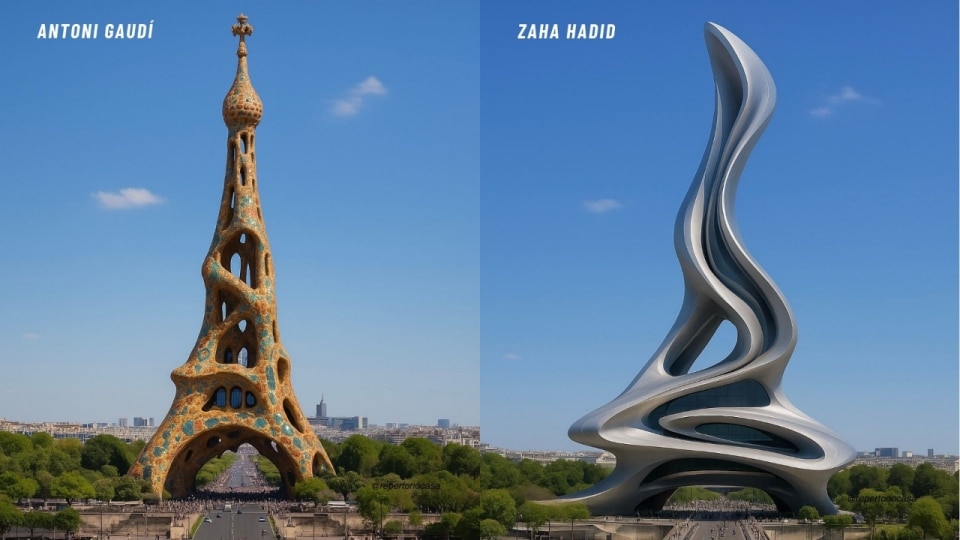4321 is the penultimate novel published during the lifetime of the great American writer Paul Auster. In this book, Auster recounts the life – or rather, the lives – of Archie Ferguson: a child who, in a single novel, becomes at least four different people, each in a distinct timeline. Something similar is happening today on Instagram, in the field of architecture.
Feeds are flooded with gallery posts that reimagine important landmarks of major cities “in the style of” other architects, as if they had been built by someone other than their original creators. Profiles such as @repertoriocasa, architectanddesign and @architectureproject behave almost like the Paul Auster of Instagram architecture.
Scrolling through their pages, you encounter – hypothesised in great detail – an Eiffel Tower designed by Zaha Hadid, the White House completely overturned by Tadao Ando and the dancing house in Prague, likewise in the hands of five different starchitects. And just like in Auster's novels, the mere existence of these architectural multiverses prompts us to rethink our relationship with AI-generated architecture.
One, two, a thousand Eiffel Towers
Say goodbye to the latticed iron grid and orthogonal pillars: in Hadid's vision, the Eiffel Tower, the symbol of Paris built for the 1889 World's Fair, would be sculpted by the wind, made of fluid, curving surfaces, more like a wave frozen in time than an engineering structure.
Even Tadao Ando, in the @architectureproject hypothesis, would completely rewrite the neoclassical style of the White House. Less celebratory and more “introspective,” with marble replaced by reinforced concrete, glass, and wood, the center of US power—if designed by the architect guest editor of Domus 2021—would perhaps also transform Americans' perception of presidential power, making it more exposed and less secretive.
The same fate befalls Vlado Milunić and Frank Gehry's Dancing House online. A symbol of post-communist Prague and East-West collaboration, some imagine it distorted in the hands of Peter Zumthor, with the two towers—one glass and one concrete—ceasing to dance and merging into a single rigorous volume.
Is nostalgia at the root of it all?
It has been 90 years since Walter Benjamin published his seminal essay on the technical reproducibility of art. There is no point in being shocked by the ease with which a style, a signature, or a design identity can be replicated “artificially.” Perhaps it is better to look at this phenomenon from another perspective: as a serious game, a form of collective rewriting, halfway between provocation and nostalgia.
The all-Italian profile of @eclissidilana helps us in this regard. An ironic designer, among other things, she had the great masters of Italian design create a new ice cream for the summer to the tune of Sapore di Sale by Gino Paoli and imagined what the M4 subway in Milan would look like if it had been designed by Gaetano Pesce, given that the current one, in her words, “is depressing”.
“I started creating these videos out of a personal need to reimagine everyday life,” she tells Domus. “Ordinary places like supermarkets and subways, everyday objects like coffee machines and vacuum cleaners are a pretext for me to construct alternative, desirable, iconic scenarios.” At the heart of this process, which combines various tools, including Midjourney and Chatgpt, and is actually much more complex than one might think, there is a certain nostalgia, a feeling that also pervades the comments of her followers: “Mine is a nostalgic gesture, but also a form of affectionate irony towards contemporary reality. With this process, in some way, it seems to me that the objects of our daily lives can regain the soul they conveyed in the past thanks to the hands of the masters of Italian design."
AI has transformed architects into aesthetics
But what kind of hand are we talking about, and what kind of soul are we missing? What emerges from much of the content generated today with artificial intelligence is not so much a nostalgia for function as for a recognizable, replicable aesthetic, or, to use the words of @eclissidilana, for something “iconic.”
Last year, on Domus, Shajay Bhooshan – co-founder of CODE, the computational research group at Zaha Hadid Architects – recalled how Hadid's designs, especially between the 1980s and 1990s, resembled cubist compositions more than planimetric studies. Those buildings would never have been buildable – or even imaginable – without parametric design. The “Hadidian” aesthetic, therefore, was not simply a style, but a direct consequence of certain technological developments.
The same applies to Gufram's Pratone and many other “groundbreaking” examples of radical Italian design, which would never have seen the light of day without the discovery and creative use of polyurethane foam.
Returning to our present, which is more complex, at least in our eyes, the past should give us hope that the samethings are happening with artificial intelligence: new formal and aesthetic languages may emerge as a direct response to technological innovation. And in some cases, such as the Liberland Metaverse—the high-fidelity virtual city imagined by Zaha Hadid Architects—this is indeed the case. “Despite what is seemingly a lack of social awareness as users concentrate on their screens, photogenic architecture and media content can provide opportunities to allow alternative interactions with people and environments,” says AI designer Refnik Anadol.
But on the other hand, we are witnessing the proliferation of real micro-aesthetics, accelerated by the rapid technological progress of AI: if a few months ago it seemed incredible to ask ChatGpt for an image “in the style of Picasso,” or for our portrait to be translated into a version similar to that of Miyazaki's films, today all it takes is the right prompts to create a video with Ettore Sottsass using a Dyson he designed. Thus, architects become pop characters and their works are treated as visual patterns to be applied and replicated. And so anyone can apply the “Tadao Ando filter” to the White House. Or imagine a clothing collection for cats... as Gio Ponti would have designed it.
Opening image: @repertoriocasa


